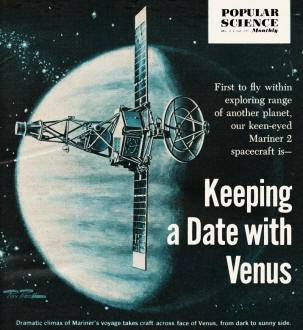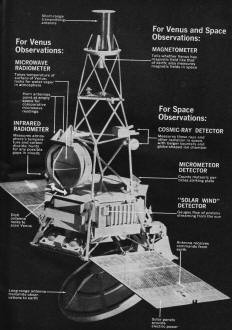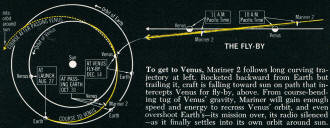|
At launch in 1962 when this
article appeared in Popular Science magazine, Mariner 2's planners imagined
Venus cloaked by benign oceans or lush swamps - temperatures perhaps only "hot-house
Earth" elevated. Microwave echoes from Earth hinted at a 600 °F surface, yet
editors clung to hope that dense clouds concealed cooler seas and maybe biology.
Infrared spectra were interpreted as carbon-dioxide greenhouse gases in a thin,
relatively clear layer; the idea of surface pressures a hundred times Earth, sulfuric-acid
rain, and global 860 °F basalt plains lay outside anyone's paradigm. A magnetosphere
like Earth's was expected; Venus instead proved geologically inert and wind-scoured,
with sluggish super-rotation. Fifty years later, radar from Magellan and Earth-borne
interferometry have overwritten 1962 optimism with images of barren basalt plains
and scorching CO₂ night.
Keeping a Date with Venus

First to fly within exploring range of another planet, our keen-eyed
Mariner 2 spacecraft is Keeping a Date with Venus
Dramatic climax of Mariner's voyage takes craft across face of
Venus, from dark to sunny side.
By Wesley S. Griswold
The world will get its first close-up look at another planet - if luck holds
out - on December 14 between 10 and 11 a.m. Pacific time.
At that likely-to-be-historic moment, the gold, silver, and blue U.S. space-craft
Mariner 2 has a date with Venus. It will fly past Earth's sister planet at such
close range, less than 21,000 miles, that Venus will loom up before it as big as
a basketball at arm's length. Instruments aboard it will scan Venus' cloud-wrapped
face.
And if no mishap has stilled the craft's radio, Mariner will send us the most
exciting news in the annals of exploration. It's expected to tell us at last what
mysterious Venus' surface and atmosphere are like, and answer the most fascinating
question of all: Can there possibly be life on Venus?
Four other attempts to explore Venus, one American and three Russian, have failed.
A Russian try last year got a spacecraft within 62,500 miles of Venus, but to no
avail - its radio had gone dead long before. Remembering that misfortune, Mariner
2's sponsors were sweating out the suspense of its 109-day voyage as this issue
went to press - but thus far, since its August 27 launching, all was going incredibly
well.
The $10,000,000, 447-pound craft on its way to Venus, built and operated for
NASA by Caltech's Jet Propulsion Laboratory, looks like a flying weather vane. It
measures 16 1/2 feet the longest way - the span of its blue-tinted solar panels.
Positioned by tiny attitude-controlling nitrogen jets, Mariner keeps these panels
always facing the sun. They turn sunlight into electricity - up to 222 watts - to
power a radio transmitter so small you could hold it in your hand, a 41-pound payload
of instruments, and Mariner's computer brain. Hinged and kept trained on Earth,
a long-range antenna sends back the instruments' reports. With almost-human talents,
the electronic brain directs all operations, following preflight instructions and
in-flight radio commands.
If an observer could watch the climax of Mariner's 180,000,000-mile journey to
Venus, he would see a breath-taking drama enacted. Gradually overhauling Venus,
Mariner will swing in toward it on a near-collision course - like one express train
racing another to an oblique crossover. Barely before Mariner reaches the crossing,
the awesome bulk of Venus will whiz across its path at more than 78,000 m.p.h. Flashing
over the crossing in hot pursuit, the even faster-moving spacecraft will catch up
with Venus - and pass alongside the planet, on its inward and sunlit side.

Venus-observing instruments of Mariner 2, together
with other instruments and principal flying gear, are shown in view opposite - on
a model of the spacecraft. Bowl resembling search-light, near center, is pivoted
dish antenna that rocks back and forth to scan Venus with radiometers that take
the planet's temperature and tell what's in its atmosphere.
Making "Eyes" at Venus
During the spectacular encounter, an eyelike instrument - a little dish antenna,
20 inches across and three inches deep, called a microwave radiometer - will ogle
Venus. Pivoted to be rocked up and down, it will scan the planet's disk in a zigzag
fashion, progressing from the dark side to the sunny side. Mounted on the edge of
the dish, so that it will always be looking at the same portion of the planet, is
a second "eye" called an infrared radiometer.
Both will pick up Venus and start their scanning at a range of 24,516 miles,
hardly more than the planet's circumference. They'll end observation just 41 minutes
and 40 seconds later, on the sunny side of Venus and only 21,291 miles away. (The
dish's right-angle mounting, and Mariner's heading, cause them to lose sight of
Venus a trifle before the closest, 20,918-mile, approach.)
Since clouds hide the planet's surface, looking at Venus with a camera would
reveal little. Radiometers provide subtler ways to pierce the cloudy mask. The microwave
instrument picks up the planet's natural or "thermal" radio emission - resulting
from its own heat-at two selected wave lengths of 13 1/2 and 19 millimeters. The
infrared instrument detects heat radiation at the shorter wave lengths of 8-9 and
10-10.8 microns.
By ingeniously piecing together the surprising variety of clues obtainable at
these particular wave lengths, scientists hope to settle wildly contrasting speculations
about Venus' surface: Is it a steaming swamp, an unbroken ocean, or a dusty and
sealing-hot desert?
Taking Her Temperature
Measuring the intensity of Venus' radio emission will tell the temperature of
the planet - the main task assigned to the microwave instrument. That will check
out an astonishing 600 degrees for Venus' surface, measured from earth by the same
new technique - if correct, a shattering blow to any hope of finding life on Venus,
and even of landing there in the future. If the long-range reading actually comes
from higher in the atmosphere - or is a false one, perhaps thrown off by an extraordinary
concentration of electrons in Venus' ionosphere - close-in measurements will show
it. As a double check, while the microwave instrument is taking the temperature
at Venus' surface, the infrared instrument will take temperatures in its atmosphere.
Does Venus have water, vital to life as we know it? The microwave instrument
should reveal that, too. If so, reception should be weak or nonexistent for the
13 1/2 mm wave length, which would be absorbed by water vapor in Venus' atmosphere.
The other, 19 mm wave length is unaffected by water vapor.
Similar telltale differences in the infrared instruments' two sets of readings
should reveal whether Venus' atmosphere contains enough carbon dioxide to account
for an oven-like surface temperature, by a "greenhouse effect." Carbon dioxide will
mask the 10-10.8-micron band but not the other, providing the needed clue. By the
same artifice, the instrument will seek to learn whether there are any breaks in
Venus' cloud blanket, through which its surface might occasionally be glimpsed.
A third Venus-observing instrument, in a metal cylinder, is a magnetometer. It
will tell" us if Venus has a magnetic field like Earth's compass-attracting one.
That will throw light, not only on the planet's interior, but also on whether it
has magnetic storms, auroras, and radiation belts - a practical concern for any
manned expedition to Venus. The magnetometer takes readings in space, too.

The Fly-By
To get to Venus, Mariner 2 follows long curving trajectory at
left. Rocketed backward from Earth but trailing it, craft is falling toward sun
on path that intercepts Venus for fly-by, above. From course-bending tug of Venus'
gravity, Mariner will gain enough speed and energy to recross Venus' orbit, and
even overshoot Earth's - its mission over, its radio silenced - as it finally settles
into its own orbit around sun.
Along the Way
As Mariner travels, still other instruments are measuring cosmic rays, the "solar
wind" of protons streaming from the sun, and the abundance of speeding micrometeors.
A crystal microphone counts pings of the meteors, like hail on a tin roof, against
an exposed magnesium plate. One of Mariner 2's first notable discoveries: Meteoric
particles are only 1/1,000 as numerous in deep space as near Earth - a happy augury
for space travel.
Mariner's progress toward Venus has been steadily watched from Earth by three
big radio telescopes. Spaced around the world at California, Australia, and South
Africa, they pass the task from one to another as the spinning earth brings each
into position. By teletype, their tracking data and reports from the spacecraft
stream into Mariner headquarters at the Jet Propulsion Laboratory in Pasadena.
At Goldstone, Calif., a tiny scientific community in a desert cupped by mountains,
are two 85-foot-diameter bowl antennas. One transmits commands to Mariner. The other
receives its reports.
To give Mariner a command - which may be either for execution at once or later
on signal - JPL sends a roll of pink perforated tape to Goldstone. An engineer there
presses a button, and the transmitting bowl flashes the message to Mariner. Thus
the spacecraft was successfully put through the most complicated maneuver any ever
performed - rolling and pitching into position, and briefly firing a tiny rocket
carried aboard - in a delicate midcourse correction assuring a bull's-eye on Venus.
Mariner itself is talking practically all the time. Over and over, it transmits
20 seconds of data from its instruments, then 17 seconds of "engineering" re-ports
about itself: its temperature inside and out, its solar panels' output of electricity,
and so on.
On sighting Venus, Mariner will switch off its engineering reports and devote
every second of the fly-by to transmitting observations of the planet-across 36,000,000
miles of space. So planned is the timing that Goldstone is the station due to receive
them.
Tom-Toms and Tape
The voice of Mariner, reporting from space, sounds like the beat of distant tom-toms.
But the eager listeners at Goldstone are not depending on their ears to transcribe
and preserve the priceless messages.
Mariner's drumlike signals are being recorded constantly on magnetic tape - five
miles of it daily. Most prized of all, if hopes are fulfilled, will be 800 precious
feet of tape, fruit of the 41-minute Venus fly-by.
At Pasadena, machines convert the magnetic-tape recordings successively into
perforations in paper tape, IBM cards, and, finally, long rows of numbers on paper
tape. As soon as scientists have had time to study and interpret these numbers,
the readings of the spacecraft's instruments, the world will know what Mariner has
discovered .
|



